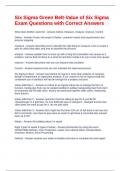Exam (elaborations)
Six Sigma Green Belt-Value of Six Sigma Exam Questions with Correct Answers
- Course
- Institution
What does DMAIC stand for - Answer-Define, Measure, Analyze, Improve, Control Define - Answer-Covers the project Charter, customer needs and requirements and process mapping measure - Answer-describes how to identify the right thing to measure, how to create a plan to collect that data, and h...
[Show more]



